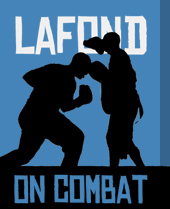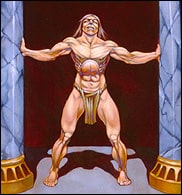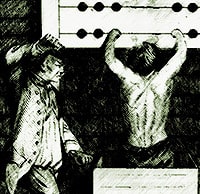Earmark is now only listed as something used on livestock. Although notching and cropping of the ear of runaways or criminals was common until 1804 in the United States. Brand came from the Germanic word for sword and we can see how the use as a noun has ascended to a very different meaning—or is it a different meaning?
Branding and burning also seem to have ancient Arуan sources related to burn and the German use of the term to apply to a sword might have been related to these in the sentiment of conquest being vested in “fire and sword.”
We might think in terms of the torch burning huts and the sword killing. But a more sustainable conquest model was the use of the sword to gain submission and the brand to label the person who takes the knee and is reduced to a commodity.
Original meaning:
-Sword, the tool of conquest, the upper class weapon of the master
Since, in later times, weapons of slave catchers, such as gunpowder, would be used to brand runaways with an R on the cheek, it is reasonable to assume that the first sign of a slave in antiquity would be of an ear notches [for the earmark has completely left the language of bondage and is now only assigned to non-human inventory concepts] with a blade or a heated blade used to brand the human property.
-The burning brand, the slave brand, the cattle mark, and branding iron evolved from the sword in terminology and use.
-The latest iteration of the brand, which is absolutely central to economic well-being in the current age, is branding as sales imagery. Everything from detergent, to an athlete, actor or writer is supposed to be branded for maximum viability. I have often been advised about “branding” myself as a writer to increase sales.
Interestingly, in the information age, the brand is malleable and through media attention, academic condemnation or infomob hysteria may be reversed. An excellent example of a brand is the externally assigned identities of Black and white, neither designation having been native to the aboriginal inhabitants of the European or African homelands.
When I was a boy, “white” was good and “black” was bad. Now, at age 58, I have lived to see a world where “white” is evil and “black” is unassailably saintly. Branding was also used to mark heretics in Christian Europe under both catholic and protestant regimes. Boring a hole in the tongue was a particularly cruel and quintessentially English form of branding.
In the modern form of the term, branding entails enslavement to the dollar, which is currency, or pure buying power, not a store of wealth and is as much related to social status and the old notion of cast as in earlier times. Only in the Information Age, the branded individual, the currency slave, has higher status than the free unbranded human who cannot command large speaking fees and only accesses currency through task completion, time toiling or crime.
Before a Germanic word was used to describe chattel marking, the ancient Romans were using branding extensively on slaves and gladiators:
Robbers, runaways, miners and condemned men were branded on the forehead. Constantine banned the branding of the face and moved it to hand, arm or calf. In this way, English and Anglo-American cheek and tongue branding exceeded the savagery of late antiquity.
Note that in the citation below, the existence of slaves in Britain before the existence of Africans there is admitted:
“By the Statute of Vagabonds (1547) under King Edward VI, vagabonds and Gypsies were ordered to be branded with a large V on the breast, and brawlers with F for "fraymaker"; slaves who ran away were branded with S on the cheek or forehead.”
The idea for branding in England primarily served as a marker for people who were not obediently staying in their place.
I suggest that a vaϲϲination record is going to serve as the postmodern vagabond brand.
Branding was used to mark the “rightless” in Europe, with France branding convicted citizens until 1832. Various brands would be affixed to slaves for life. Time slaves would not be branded unless they were criminals or runaways and this mark reduced them in some cases to a slave for life, such as in Plantation Virginia, where running away a third time made one a slave for life.
B for blasphemy was a confirmed English practice against Quakers.
M for malefactor was a common English brand on the hands for the criminal.
German Anabaptists were burned with a cross on the forehead by the Church.
New England adulterers or drunks would be branded on the chest with an A or a D.
England would hold on to branding the longest.
“Such cases led to branding becoming obsolete, and it was abolished in 1829 except in the case of deserters from the army, who were marked with the letter D, not with hot irons but by tattooing with ink or gunpowder.[citation needed] Notoriously bad soldiers were also branded with BC (bad character). The British Mutiny Act of 1858 provided that the court-martial might, in addition to any other penalty, order deserters to be marked on the left side, 2 inches (5 cm) below the armpit, with the letter D, such letter to be not less than an inch long. In 1879 this was abolished.”
Even the savage Russians banned branding in 1863.
Union soldiers fighting in Virginia in 1865 were branded with a D for desertion.
The cover of the book Stillbirth of a Nation shows thieves being, whipped, branded and hung in Denmark.
The sources on American slave branding cited in Wikipedia are only for African Americans, ignoring that these exact same brands had been used on their European American co-slaves and predecessors, with R on the cheek or forehead the most common mark.
Closer to the modern concept of branding was the practice of branding whores by criminals and pimps which continues to this day and serves as a link between hallowed antiquity and hollowed modernity.
Explore Plantation America at Patreon:
link › patreon.com/jameslafond











People now pay to brand themselves. Is tattooing yourself sign of a slave mind or an attempt at rebellion?
Most see it as self-expression, or marking important events or people. Or a stint in prison. Some Christians tattoo Bible verses, regardless of what the Bible says.
Maybe as civilization decays, old meanings are meaningless, and brands don't mean what they used to. I would never voluntarily mark myself, but the world I was born into is mostly gone.
At this point most such attempts to self mark are simply a search for identity. That identity was once provided by a master. Now it is internally assigned. But once marked with a brand, the society will decide unconsciously or consciously what that brand means. The mark is a social handle still, even if barren of specific meaning. I too would decline to attach a social lever to my person.
@New Ledford
I know right? That is absolutely ridiculous. I think it is a 'sign' of trendy douchebaggetry.
@James LaF
This is interesting stuff about branding. The info you've provided regarding the intricacies of daily slave life, um excuse me, 'indentured servant' life are just overwhelming.
But, according to this old song here below, that sort of thing wouldn't be done to honkies James. So who's right here?
youtube.com/watch?v=W963B2zKMD8
will answer as an article, sir.